The opening exhibition entitled “UTOPIA - An Anonymous Place” will be staged at ART BASE MOMOSHIMA and other sites in the surrounding area. The term “utopia” was originally coined by English thinker Sir Thomas More as the name for an imaginary, ideal nation. After its coinage the term was used in a variety of ways - becoming the basis for ideas critical of society, refering to literature set in imaginary societies, and becoming most widely used to indicate an optimistic view of an ideal world. This exhibition likens the original Greek term “outopos” (“ou”- not, “topos” - place), meaning “an anonymous place,” with the unique envirionment of Momoshima - an isolated island in the Seto Inland Sea, and a world apart from large cities. By sharing this most basic of living environments and creating art works specific for the sight, each artist offers their vision of a contemporary utopia through their work.
Venue: ART BASE MOMOSHIMA / Momoshima Fukuda and Honmachi areas
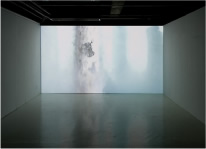
"Chronos" 2010
Born in Ōita in 1987 and currently lives in Hiroshima.
Graduated from The Kyoto University of Art and Design, Department of Fine and Applied Arts, Mixed Media Course in 2009, and is currently enrolled in the Comprehensive Design and Arts doctorate program at Hiroshima City University Graduate School of Arts. He began to distinguish himself as an artist when he was awarded the “ULTRA AWARD 2010” (organized by Kyoto University of Art and Design and ULTRA FACTORY) for his dramatic and uniquely filmed video installations. He has been actively showing new work in exhibitions such as “Hiroshima Art Project 2009” (Yoshijima area, Nakaku, Hiroshima City), “Trans-Plex” (Kuandu Museum of Fine Arts, Taipei, 2011), and “Hiroshimao Hiroshima Fukushima” (Former Bank of Japan, Hiroshima Branch). His delicate video work of gradually dissolving pots and pipes made out of basic rudimentary materials such as clay and cement dispersing into the water reflects its title, “Chronos x Kairos,” ancient Greek terms that indicate different aspects of time. As is evident in “Chronos x Kairos,” Isayama’s work seeks the intersection of the free flowing time in our imagination, and time which progresses in a fixed and absolute manner.
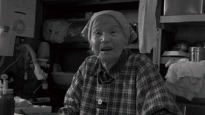
"Stories about Yoshijima" 2007
Born in Tokyo in 1974 and currently lives in Fukuoka.
After graduating from Musashino Art University, he joined Yukinori Yanagi in creating the Inujima Art Project. Since 2004, he has been creating animation, computer graphics, and art documentaries for television programs directed at art museums, collaborating with renowned artists such as Katsuhiko Hibino and Katsushige Nakahashi. For the 2007 “Hiroshima Art Project” (Yoshijima district and the Former Bank of Japan, Hiroshima Branch), he created video works of the local residents of the Yoshijima area, discussing their thoughts on the history of the town and on the art project, as well as another video piece showing the security guards who once worked at the former Hiroshima branch of the Bank of Japan (another venue of the event) talking about the building where they had worked for many years. Recently, he has been working as the cinematographer for Australian contemporary artist Susan Norries’ work (shown at the Yokohama Triennale 2011 ), and is traveling across the country gathering footage of the Tohoku area for the numerous earthquake-related reconstruction projects he takes part in. In 2004, he opened the “RECOMEMO WORKSHOP & STUDIO” in Fukuoka.

"Tectonic Model" 2008
Born in Hiroshima in 1975 and currently resides there.
After completing his doctorate at the Hiroshima University Graduate School of Arts, he moved to England to pursue further education. In 2005, he graduated from the Graduate School of Edinburgh College of Art. Although he has had plenty of experience overseas, the artist chooses to base himself in Hiroshima, his hometown. Domestically, he has shown works in exhibitions such as “Roppongi Crossing 2007: Future Beats in Japanese Contemporary Art” (Mori Art Museum, Tokyo) and “Yokohama Triennale 2011: OUR MAGIC HOUR” (Yokohama Museum of Art, Kanagawa), and others. He has recently participated in numerous international exhibitions such as la Biennale de Lyon (France) in 2009, and “Double Vision - Contemporary Art from Japan” (Russia / Israel, 2012). The materials he uses, such as bits of cloth and old books which he discovered during his time in England where he was forced to face the struggles of everyday life, are reused to craft steel towers and cranes in an intricate landscape of miniatures, creating a delicate installation. He has also proved his skill as an organizer, showing leadership among the artists in the 2007 and 2009 Hiroshima Art Projects.

"Ways of Worldmaking" 2010
Collectif_fact is the pairing of artists Annelore Schneider (born in Neuchâtel, Switzerland, 1979) and Claude Piguet (born in Neuchâtel, Switzerland, 1977). Schneider and Piguet live in Geneva and London. The pair handle computer graphics, photography, and film technology with great finesse, and debuted with a video work that wanders through a scene made of visuals of street lights and signboards extracted from urban scenery, which vividly expresses skepticism towards today’s society and its strong ties to capitalist structures. In 2011, they won the Swiss Art Awards 2011 for their video work “Ways of World Making.” The work shows a man delivering a speech on the ideals of society, which are actually fragments of lines from Hollywood film previews pieced together. Their major exhibitions include “World Making” (Centred'Art Contemporain Genève, Geneva, Switzerland, 2011) and “Ways of Worldmaking” (Galerie Mitterrand + Sanz/Zurich, Switzerland, 2011) and others.
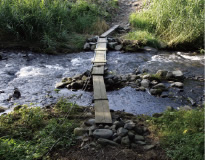
"bridge" 2011
Born in Okayama in 1978, and currently lives in Osaka.
After graduating from Musashino Art University, he began to make work based on his travels and fieldwork, capturing them in photography and text. He continues to make new work in this fashion as well. In 2005, he produced a photo book entitled “Bunkers” published by Little More, in which he researched and photographed the remains of long forgotten military activity from all over Japan. Shitamichi has produced series of works that present viewers with a condensed account of people’s activities and memories, hidden in a landscape of varying scales. In the series entitled “torii,” Shitamichi went around the edge of Japan to research and photograph existing conditions of remains from the Japanese occupation. Another series entitled “bridge” is a collection of images of make-shift bridges made of wooden boards and cement blocks placed across irrigation ditches. Recently, he has been active abroad and domestically, participating in residency programs in France, Vietnam, and Japan, as well as winning the Noon Award at this year’s Gwangju Biennial (Korea), which is awarded to emerging artists. He also showed his work in “Hiroshima Art Project” (Former Bank of Japan, Hiroshima Branch) and at “What a Wonderful World: Visions in Contemporary Asian Art of Our World Today” (Hiroshima Museum of Contemporary Art, 2012).
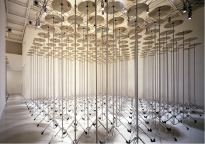
"flooring" 2008
Born in Hiroshima in 1977 and currently living in Hiroshima.
After graduating from Musashino Art University’s Graduate School of Art and Design in 2003, he has continued to produce new work, mainly in Tokyo. In 2008, he won the grand prize for shiseido art egg 2, an open competition organized by Shiseido Gallery for his installation in which he created a golden surface covering the gallery space with a virtually uncountable number of cymbals. He has created works that have the ability to capture the salient features of a space, regardless of its style or size, and transform it by installing ready mades, such as his work which introduces a bowling ball return rack into a gallery renovated from an apartment. From 2009, he spent two years in London under the Agency of Cultural Affairs overseas program. After his residency at the Florence Trust in London, he began to incorporate aspects of painting into his work. In 2007, he exhibited work at the “Hiroshima Art Project” (Former Bank of Japan, Hiroshima Branch). He contributed in renovating ART BASE MOMOSHIMA, and will be inaugurating a new installation - a rarity since he has not recently presented any work in Japan.
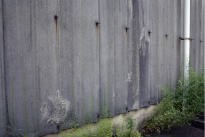
"Landscape Drawing on the Wall" 2009
Born in Hiroshima in 1985 and currently lives there.
Now pursuing his doctorate at Hiroshima City University’s Graduate School of Arts. While maintaining the structure of painting in its most minimal form, he has managed to create a series of unconventional paintings by incorporating everyday materials into his work. From 2009-2010, he took part in shows in Germany such as “Aussenstelle Fernsehturm” (Berliner Fernsehturm, Germany, 2010) and “Anonymous Drawing N°10” (Kunstraum Kreuzberg Bethanien, Germany, 2010), while taking part in an exchange program with Kunsthochschule Berlin-Weißensee’s Department of Painting. In Hiroshima, he has shown works in “Hiroshimao, Hiroshima Fukushima” (Former Bank of Japan, Hiroshima Branch) and also in “Hiroshima Art Project 2009” (Yoshijima area, Nakaku, Hiroshima City), where he made an outdoor work using the walls of a building as the canvas. This graffiti-like site-specific work in which he removed dirt from parts of the wall to create a Japanese ink painting, drew much attention not only from visitors but from local residents of the area as well.

"Win-dow" 2011
Mouhitori is an artistic unit comprised of Tamaki Ono (born in Hokkaido, 1973, graduate of Tokyo University of the Arts, Graduate School of Fine Arts), and Kiyohito Mikami (born in Kagoshima, 1973, graduate of Tokyo University of the Arts, Graduate School of Fine Arts), who live in Onomichi, Hiroshima. The two have been active in Onomichi from 2005, making work related to specific locations/occasions, and conducting workshops. From 2007, they have been organizing residencies (AIR Onomichi) at facilities and vacant houses in the Yamate area of Onomichi, and operating its platform organization, called the Komyoji Kaikan. Also a part of the Onomichi Akiya Saisei Project, which works toward rejuvenating abandoned houses, the unit took inspiration from events and places that would otherwise inevitably be forgotten as the town changes, and created an installation piece using light, building material, and plants. They have been showing this piece across the country. In 2008, they were invited to Hiroshima Art Document and an art event in Prague. In the 2010 AIR Onomichi, they transformed an abandoned building into a gathering place by illuminating the rampant vegetation with fluorescent lights, creating a stage for dance performances.

"Beautiful Limit - Adventure into
the endless chaos -" 2010
Born in Tokyo in 1975, currently lives in Shodoshima, Kagawa.
She graduated from the Hiroshima City University’s Faculty of Art, Department of Design and Applied Arts in 2002. She began mountain climbing in her university years, and she creates imaginative landscape works inspired by the great and unforgiving wilderness that she has experienced. Although she paints unnatural landscapes, piecing together minute details of reality that exist but cannot be captured from a distance, her encounters with nature around Los Angeles and in Finland have, strangely enough, enabled her work to attain an air of realism. Her representative work “Beautiful Limit,” which was first shown in her solo exhibition at the Tokyo Opera City Art Gallery in 2011, is still an ongoing work in progress. Now reaching over 50 meters in length and continuing to grow, it is a landscape unlike any before encountered. She has also been taking on the challenge of venturing into other media. In 2011, she took part in a residency program in Shodoshima, Kagawa, where she created a sculpture from a drawing of the island in its entirety, based on personal field work.


